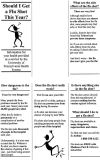Educational content and the effectiveness of influenza vaccination reminders
- PMID: 10571718
- PMCID: PMC1496760
- DOI: 10.1046/j.1525-1497.1999.11098.x
Educational content and the effectiveness of influenza vaccination reminders
Abstract
Objective: To determine if a mailed patient education brochure (addressing demonstrated reasons for vaccination refusal) would result in a higher rate of influenza vaccination than a mailed postcard reminder without educational content.
Design: Randomized, controlled trial.
Setting: Urban, predominantly African-American, low-income community.
Participants: There were 740 community-dwelling individuals aged 65 years and older in the study.
Measurements: Receipt of influenza vaccination and beliefs about influenza and influenza vaccination were measured by telephone survey self-report.
Main results: We successfully contacted 202 individuals (69.9%) who received the postcard reminder and 229 individuals (71.1%) who received the educational brochure. People receiving the educational brochure were more likely to report influenza vaccination during the previous vaccination season than those who received the postcard reminder (66.4% vs 56.9%, p =.04). They also reported more interest in influenza vaccination in the coming year. (66.5% vs 57.1%, p =.05).
Conclusions: A mailed educational brochure is more effective than a simple reminder in increasing influenza vaccination rates among inner-city, elderly patients.
Figures
References
-
- Centers for Disease Control. Prevention and control of influenza: Recommendations of the Advisory Committee on Immunization Practices. MMWR. 1997;46 - PubMed
-
- Public Health Service . Healthy People 2000: National Health Promotion and Disease Prevention Objectives. Washington, DC: US Department of Health and Human Services, Public Health Service; 1991. pp. 121–3.
-
- Nichol KL, Margolis KL, Wuorenma J. The efficacy and cost-effectiveness of vaccination against influenza among elderly persons living in the community. N Eng J Med. 1994;331:778–84. - PubMed
-
- Fedson DS, Wadja A, Nicol JP. Clinical effectiveness of influenza vaccination in Manitoba. JAMA. 1993;270:1956–61. - PubMed
-
- Foster DA, Talsma A, Furumoto-Dawson A, Ohmit SE, Margulies JR, Arden NH, Monto AS. Influenza vaccine effectiveness in preventing hospitalization for pneumonia in the elderly. Am J Epidemiol. 1992;136:296–307. - PubMed
Publication types
MeSH terms
Substances
Grants and funding
LinkOut - more resources
Full Text Sources
Medical


